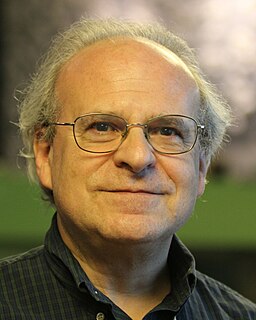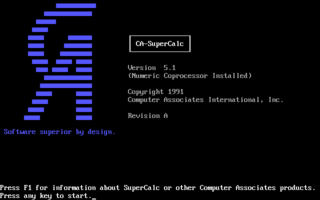Related Research Articles

The Apple II is an 8-bit home computer and one of the world's first highly successful mass-produced microcomputer products. It was designed primarily by Steve Wozniak; Steve Jobs oversaw the development of Apple II's foam-molded plastic case and Rod Holt developed the switching power supply. It was introduced by Jobs and Wozniak at the 1977 West Coast Computer Faire, and marks Apple's first launch of a personal computer aimed at a consumer market—branded toward American households rather than businessmen or computer hobbyists.

Robert M. Frankston is an American software engineer and businessman who co-created, with Dan Bricklin, the VisiCalc spreadsheet program. Frankston is also the co-founder of Software Arts.

Daniel Singer Bricklin is an American businessman and engineer who is the co-creator, with Bob Frankston, of the VisiCalc spreadsheet program. He also founded Software Garden, Inc., of which he is currently president, and Trellix Corporation. He currently serves as the chief technology officer of Alpha Software.
Lotus 1-2-3 is a discontinued spreadsheet program from Lotus Software. It was the first killer application of the IBM PC, was hugely popular in the 1980s, and significantly contributed to the success of IBM PC-compatibles.

Multiplan was an early spreadsheet program developed by Microsoft. Known initially by the code name "EP", it was introduced in 1982 as a competitor for VisiCalc.

The TRS-80 Micro Computer System is a desktop microcomputer launched in 1977 and sold by Tandy Corporation through their Radio Shack stores. The name is an abbreviation of Tandy Radio Shack, Z80 [microprocessor]. It is one of the earliest mass-produced and mass-marketed retail home computers.

VisiCalc was the first spreadsheet computer program for personal computers, originally released for Apple II by VisiCorp in 1979. It is often considered the application that turned the microcomputer from a hobby for computer enthusiasts into a serious business tool, prompting IBM to introduce the IBM PC two years later. VisiCalc is considered to be Apple II's killer app. It sold over 700,000 copies in six years, and as many as 1 million copies over its history.

Lotus Improv is a discontinued spreadsheet program from Lotus Development released in 1991 for the NeXTSTEP platform and then for Windows 3.1 in 1993. Development was put on hiatus in 1994 after slow sales on the Windows platform, and officially ended in April 1996 after Lotus was purchased by IBM.
In marketing terminology, a killer application is any computer program or software that is so necessary or desirable that it proves the core value of some larger technology, such as computer hardware, a video game console, software, a programming language, a software platform, or an operating system. In other words, consumers would buy the hardware just to run that application. A killer app can substantially increase sales of the platform on which it runs.

The West Coast Computer Faire was an annual computer industry conference and exposition most often associated with San Francisco, its first and most frequent venue. The first fair was held in 1977 and was organized by Jim Warren and Bob Reiling. At the time, it was the biggest computer show in the world, intended to popularize the personal computer in the home. The West Coast PC Faire was formed to provide a more specialized show. However, Apple Inc. stopped exhibiting at the West Coast Computer Faire, refusing to exhibit at any show other than COMDEX that also had PC-based exhibits.

VisiCorp Visi On was a short-lived but influential graphical user interface-based operating environment program for IBM compatible personal computers running MS-DOS. Although Visi On was never popular, as it had steep minimum system requirements for its day, it was a major influence on the later development of Microsoft Windows.
VisiCorp was an early personal computer software publisher. Its most famous products were Microchess, Visi On and VisiCalc.
The software industry includes businesses for development, maintenance and publication of software that are using different business models, mainly either "license/maintenance based" (on-premises) or "Cloud based". The industry also includes software services, such as training, documentation, consulting and data recovery.

SuperCalc is a CP/M-80 spreadsheet application published by Sorcim in 1980.
Randy Wigginton was one of Apple Computer's first employees (#6), creator of MacWrite, Full Impact, and numerous other Mac applications. He used to work in development at eBay, Quigo, Inc and Move.com. In November 2010, he left his position as a "site reliability engineer" at Google Inc., purportedly after leaking news of a $1,000 holiday cash bonus to employees.
wikiCalc is a web application, created by Dan Bricklin, that allows for the creation and editing of spreadsheets through a wiki-style user-editable interface. It is currently released as version 1.0 for use on Windows, Mac, Linux/Unix, and other platforms that can run the Perl language.
Microchess, by Peter R. Jennings, was the first commercially successful chess program for microcomputers. Originally designed for the MOS Technology KIM-1 it was released on December 18, 1976. Microchess, as small as it was in terms of program size, could still play passable chess on the KIM-1 with its 6502 microprocessor, 1 kilobyte of memory, simple hex keyboard, and seven-segment display.
Advanced Computer Techniques (ACT) was a computer software company most active from the early 1960s through the early 1990s that made software products, especially language compilers and related tools. It also engaged in information technology consulting, hosted service bureaus, and provided applications and services for behavioral health providers. ACT had two subsidiaries of note, InterACT and Creative Socio-Medics.
Peter R. Jennings is a Canadian physicist, scientist, inventor, software developer, computer chess programmer, and entrepreneur. He is best known for creating MicroChess, the first microcomputer game to be sold commercially in 1976.
Informatics General Corporation, earlier Informatics, Inc., was an American computer software company in existence from 1962 through 1985 and based in Los Angeles, California. It made a variety of software products, and was especially known for its Mark IV file management and report generation product for IBM mainframes, which became the best-selling corporate packaged software product of its time. It also ran computer service bureaus and sold turnkey systems to specific industries. By the mid-1980s Informatics had revenues of near $200 million and over 2,500 employees.
References
- 1 2 Fylstra, Dan (March 1978). "User's Report: The PET 2001". BYTE. p. 114. Retrieved 17 October 2013.
- ↑ "Sagas of Five Who Made It". Time Magazine . Feb 15, 1982. Archived from the original on November 3, 2012.
- ↑ Kenneth M. Pierce and Michael Moritz (Oct 5, 1981). "Software for the Masses". Time Magazine . Archived from the original on September 28, 2006.
- ↑ Fylstra, Dan (April 1978). "The Radio Shack TRS-80: An Owner's Report". BYTE. p. 49. Retrieved 17 October 2013.
- ↑ "VisiCalc of Dan Bricklin and Bob Frankston" (July 2011)
- ↑ Paul Ceruzzi, A History of Modern Computing (MIT Press, 1998), quote 267.
- ↑ Martin Campbell-Kelly From Airline Reservations to Sonic the Hedgehog: A History of the Software Industry (MIT Press, 2003), 215.
- ↑ Martin Campbell-Kelly From Airline Reservations to Sonic the Hedgehog: A History of the Software Industry (MIT Press, 2003), 211.